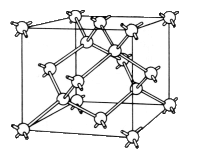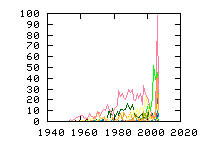« Previous
1
Next »
(8 hits, 1/1)
Showing
10, 25, 50, 100, 500, 1000, all papers per page.
Sort by:
last publication date,
older publication date,
last update date.
- 1. Appl. Phys. Lett. 90, 013116 (2007) , “Onset of stacking faults in InP nanowires grown by gas source molecular beam epitaxy”, D. M. Cornet, V. G. M. Mazzetti, and R. R. LaPierreInP nanowires (NWs) were grown by gas source molecular beam epitaxy on InP (111)B substrates, using Au nanoparticles as a growth catalyst. The rod-shaped NWs exhibited hexagonal sidewall facets oriented along the {−211} family of crystal planes for all NW diameters, indicating minimal... (Read more)
- 2. J. Appl. Phys. 100, 123519 (2006) , “Origin of deep level defect related photoluminescence in annealed InP”, Youwen Zhao, Zhiyuan Dong, Shanshan Miao, Aihong Deng, Jun Yang, and Bo WangDeep level defects in annealed InP have been studied by using photoluminescence spectroscopy (PL), thermally stimulated current (TSC), deep level transient spectroscopy (DLTS), and positron annihilation lifetime (PAL). A noticeable broad PL peak centered at 1.3 eV has been observed in the InP... (Read more)
- 3. J. Appl. Phys. 100, 073702 (2006) , “Size and shape effects on excitons and biexcitons in single InAs/InP quantum dots”, N. Chauvin, B. Salem, G. Bremond, G. Guillot, C. Bru-Chevallier, and M. GendrySingle InAs quantum dots grown on an InP vicinal substrate are studied using polarized microphotoluminescence. The study of electron-hole exchange energy splitting reveals that the energy splitting is influenced by quantum confinement. The biexciton binding energies found for single dots grown on... (Read more)
- 4. J. Appl. Phys. 100, 023539 (2006) , “Mechanisms for the activation of ion-implanted Fe in InP”, T. Cesca, A. Verna, G. Mattei, A. Gasparotto, B. Fraboni, G. Impellizzeri, and F. PrioloIn this paper we present structural and electrical investigations on high temperature Fe-implanted InP. The aim of the work is to relate the lattice position of the implanted atoms after annealing treatments (from 300 to 600 °C) with their electrical activation as compensating deep traps and... (Read more)
- 5. Phys. Rev. B 74, 235210 (2006) , “Dislocation-induced deep electronic states in InP: Photocapacitance measurements”, Yutaka Oyama, Jun-ichi Nishizawa, Toshihiro Kimura, and Takenori TannoPhotocapacitance and excitation photocapacitance methods were applied to reveal the dislocation-induced deep levels in coalescent epitaxial lateral overgrowth layers of InP. Point-contact Schottky barrier junctions with small junction areas were formed on dislocated and dislocation-free regions by... (Read more)
- 6. Phys. Rev. B 74, 075332 (2006) , “Point defects on the (110) surfaces of InP, InAs, and InSb: A comparison with bulk”, A. Höglund, C. W. M. Castleton, M. Göthelid, B. Johansson,, and S. MirbtThe basic properties of point defects, such as local geometries, positions of charge-transfer levels, and formation energies, have been calculated using density-functional theory, both in the bulk and on the (110) surface of InP, InAs, and InSb. Based on these results we discuss the electronic... (Read more)
- 7. Phys. Rev. Lett. 97, 226401 (2006) , “Quasiparticle Corrections to the Electronic Properties of Anion Vacancies at GaAs(110) and InP(110)”, Magnus Hedström, Arno Schindlmayr, Günther Schwarz, and Matthias SchefflerWe propose a new method for calculating optical defect levels and thermodynamic charge-transition levels of point defects in semiconductors, which includes quasiparticle corrections to the Kohn-Sham eigenvalues of density-functional theory. Its applicability is demonstrated for anion vacancies at... (Read more)
- 8. Physica B 273, 837 (1999) , Elsevier Science , “Deep levels associated with alpha irradiation of n-type MOCVD InP”, M. Zafar Iqbal, U. S. Qurashi, A. Majid, Aurangzeb Khan, Nasim Zafar, A. Dadgar, D. BimbergDeep level transient spectroscopy has been used to observe the effect of alpha particle irradiation on n-type InP grown by metal organic chemical vapour deposition (MOCVD). Eight majority carrier emitting levels Eα1, Eα2, …, Eα8 are found to be produced as a result of this irradiation. At least two of the observed levels (Eα2 and Eα4) are found to show interesting metastable behaviour. One important result of this work is complete absence of the well-known metastable M-level (observed in electron irradiated LEC InP) in our alpha-irradiated MOCVD material. (Read more)
« Previous
1
Next »
(8 hits, 1/1)
Showing
10, 25, 50, 100, 500, 1000, all papers per page.
Sort by:
last publication date,
older publication date,
last update date.
All papers (3399)
Updated at 2010-07-20 16:50:39
Updated at 2010-07-20 16:50:39
(view as: tree
,
cloud
)
| 1329 | untagged |
Materials
(111 tags)
Others(101 tags)
Technique
(46 tags)
Details
(591 tags)
Bond(35 tags)
Defect(interstitial)(18 tags)
Defect(vacancy)(15 tags)
Defect-type(19 tags)
Element(65 tags)
Energy(8 tags)
Isotope(56 tags)
Label(303 tags)
Sample(17 tags)
Spin(8 tags)
Symmetry(15 tags)

